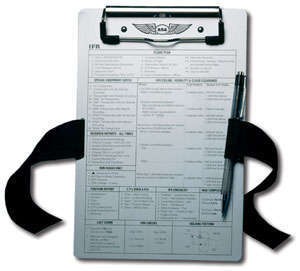I am currently working on my instrument rating. A key to Instrument flying is single pilot resource management. There are many things happening in the same time and you need everything setup correctly to be able to be on top of your game. I have been flying with a kneeboard for notes for a while now and the pen with a cap has proved to be working just fine when flying VFR. Interestingly though after the first instrument flying lesson, I threw these pens out of the window (not literally) and changed them with pens without cap. Flying the plane by instruments requires a lot of attention. More than 5 seconds of distraction can get you into a bank, above or below the assigned altitude. The left hand is on the yoke flying the plane, now try to copy a clearance or ATC authorization, while taking off the cap of a pen or putting it back on (if you can find it). The pen has to be handled single-handed! Even these turning pens can be a pain.

Something so simple and yet impactful, made me think about a list of equipment considerations.
- Kneeboard for notes
I prefer simple, nothing to open or to close. It seems like anything additional could get in my way and I try to organize the cockpit in a very simple yet functional way. Simple kneeboards go for US15.00 or less. - Single-hand Pen
Discussed in introduction.

- Headlamp for night flight
The first night flight I did in instrument training, I had my kneeboard setup and copied a clearance. Only problem was that I couldn’t really read it. The cockpit has a little lamp, but that wouldn’t illuminate far enough. A headlamp is very useful, because it will follow you direction of view. Even when having an electrical failure you might actually be able to read your non-electrical instruments. Now white or red light. Red light doesn’t affect your nigh vision, white light is easier to see with, but does affect your night vision. You could argue that while flying IFR the only thing you need to see is your cockpit instruments. True, but if you get into visual instruments at night, I wouldn’t just jive that privilege away. Your call, I will prefer red over white. I will let you know if a change my opinion after some time into instrument flying.
I purchased a headlight for US41.00. You can find other much cheaper. - IFR Electric Chart Subscription
Jeppesen sells Latin America Electronic Charts (Single Install with Annual Subscription) for US195.00 yearly subscription fee. That will give you a single device install and updated charts all the time.Example: http://ww1.jeppesen.com/aviation/products/mobile-flitedeck/index.jsp
- Knee strap or other kind of installation (suction cup)
So now you have the charts on your iPad (or any other tablet). You will need the charts somewhere handy. I got a suction cup, but might try a knee strap in the future. I will have to play around with this, but I am thinking that having the charts on one leg and my notes on the other, might be useful, especially when briefing an approach. For now I got the suction mount, let’s see how it goes. - External GPS Receiver
Turns out that the iPad GPS receiver is not accurate enough. The Jeppesen Mobile FLightDeck application doesn’t show chart overlay until a certain accuracy can be assured.

- Update IFR Charts of your GPS enabled navigation device
Especially when you are allowed to use your GPS for instrument flight, you want to get an update of the database. I found the updates for my 430W on Jeppesen.
I hope you find my list helpful. Let me know what you think or if I am missing something. As mentioned in the beginning, I am just starting my IFR journey.
Happy Flying!




Pingback: A new article about IFR equipment | Guatemala Skies
Como siempre muy acertados y útiles comentarios
Gracias